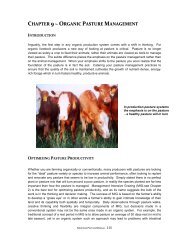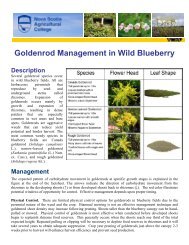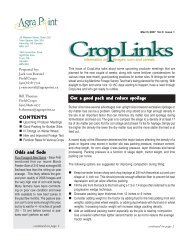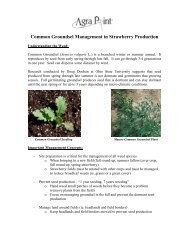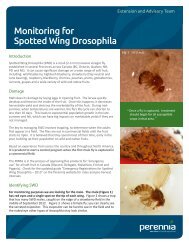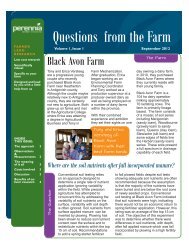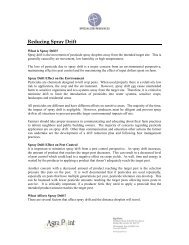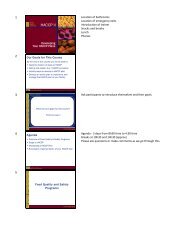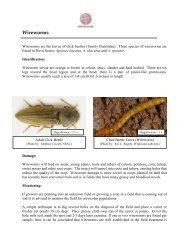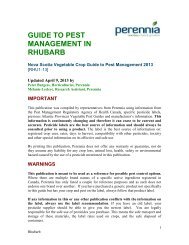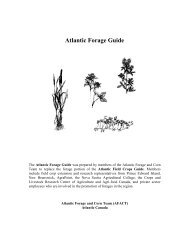Guide to Pest Management in Field Tomato 2013 - Perennia
Guide to Pest Management in Field Tomato 2013 - Perennia
Guide to Pest Management in Field Tomato 2013 - Perennia
Create successful ePaper yourself
Turn your PDF publications into a flip-book with our unique Google optimized e-Paper software.
Extension and Advisory Team<br />
Toma<strong>to</strong><br />
<strong>Management</strong> Schedule<br />
A guide <strong>to</strong> weed, <strong>in</strong>sect and<br />
disease management <strong>in</strong> field<br />
<strong>to</strong>ma<strong>to</strong> <strong>in</strong> Nova Scotia<br />
<strong>2013</strong>
GUIDE TO PEST<br />
MANAGEMENT IN<br />
FIELD TOMATO<br />
Nova Scotia Vegetable Crop <strong>Guide</strong> <strong>to</strong> <strong>Pest</strong> <strong>Management</strong> <strong>2013</strong><br />
[TOM2-13]<br />
Updated June 4, <strong>2013</strong> by<br />
Peter Burgess, Horticulturist, <strong>Perennia</strong><br />
Mélanie Leclerc, Research Assistant, <strong>Perennia</strong><br />
IMPORTANT<br />
This publication was compiled by representatives from <strong>Perennia</strong> us<strong>in</strong>g <strong>in</strong>formation from<br />
the <strong>Pest</strong> <strong>Management</strong> Regula<strong>to</strong>ry Agency of Health Canada, specific pesticide labels,<br />
previous Atlantic Prov<strong>in</strong>ces Vegetable <strong>Pest</strong> <strong>Guide</strong>s and manufacturer’s <strong>in</strong>formation. This<br />
<strong>in</strong>formation is cont<strong>in</strong>uously chang<strong>in</strong>g and therefore it can cease <strong>to</strong> be current and<br />
accurate. <strong>Pest</strong>icide labels are the best source of <strong>in</strong>formation and should always be<br />
consulted prior <strong>to</strong> us<strong>in</strong>g a product. The label is the best source of <strong>in</strong>formation on:<br />
registered crop uses, rates, days <strong>to</strong> harvest, compatibility with other pesticides, <strong>to</strong>xicity<br />
and other special <strong>in</strong>formation on its effective and safe use<br />
By pr<strong>in</strong>t<strong>in</strong>g this publication, <strong>Perennia</strong> does not offer any warranty or guarantee, nor do<br />
they assume any liability for any crop loss, animal loss, health, safety or environmental<br />
hazard caused by the use of a pesticide mentioned <strong>in</strong> this publication.<br />
WARNINGS<br />
This publication is meant <strong>to</strong> be used as a reference for possible pest control options.<br />
Where there are multiple brand names of a specific active <strong>in</strong>gredient registered <strong>in</strong><br />
Canada, <strong>Perennia</strong> has only listed a couple for reference purposes and as such does not<br />
endorse one brand over another. If you have purchased a generic product not specifically<br />
<strong>in</strong> this guide but has your crop and pest on the label, always follow that product label.<br />
If any <strong>in</strong>formation <strong>in</strong> this or any other publication conflicts with the <strong>in</strong>formation on<br />
the label, always use the label recommendation. If you have an old label, your<br />
pesticide supplier should be able <strong>to</strong> give you the newest label. You are legally<br />
responsible for the safe use of pesticides you purchase. This means the safe transport and<br />
s<strong>to</strong>rage of these materials, the label rates used on crops, and the safe disposal of<br />
conta<strong>in</strong>ers.<br />
Toma<strong>to</strong><br />
1
<strong>Pest</strong><br />
WEEDS:<br />
Group<br />
Active<br />
Ingredient<br />
<strong>Pest</strong>icide<br />
Product<br />
Name<br />
Rate<br />
Restricted-<br />
Entry<br />
Interval<br />
(REI)<br />
Preharvest<br />
Interval<br />
(days)<br />
Remarks<br />
Preplant<br />
<strong>Perennia</strong>l weeds<br />
<strong>in</strong>clud<strong>in</strong>g<br />
quackgrass<br />
9 glyphosate Roundup 356 Sn 1.25-2.5<br />
L/ha<br />
14 carfentrazoneethyl<br />
Roundup<br />
WeatherMAX<br />
1.67-8.0<br />
L/ha<br />
Touchdown 480 2.5-7.0<br />
L/ha<br />
Aim EC 36.5-117<br />
mL/ha<br />
-<br />
12 hours<br />
12 hours<br />
7<br />
7<br />
7<br />
Apply <strong>in</strong> the fall or spr<strong>in</strong>g<br />
prior <strong>to</strong> plant<strong>in</strong>g. Annual<br />
weed control programs will<br />
be necessary <strong>to</strong> control weeds<br />
germ<strong>in</strong>at<strong>in</strong>g after plant<strong>in</strong>g.<br />
For quackgrass control, apply<br />
<strong>to</strong> actively grow<strong>in</strong>g<br />
quackgrass when at least 4<br />
new leaves are present. The<br />
low rate (2.5 L/ha) will<br />
provide a m<strong>in</strong>imum of one<br />
season control, while higher<br />
rates (4.75 <strong>to</strong> 7 L/ha) will<br />
provide longer term control.<br />
The low rate of Roundup<br />
should be applied <strong>in</strong> 50 <strong>to</strong><br />
100 L/ha water. If higher<br />
water volumes are used add a<br />
suitable surfactant. Wait 72<br />
hours before plow<strong>in</strong>g under.<br />
Best control of quackgrass is<br />
obta<strong>in</strong>ed when these<br />
herbicides are applied <strong>in</strong> the<br />
fall.<br />
12 hours 1 Apply <strong>in</strong> m<strong>in</strong>imum spray<br />
volume of 100 L/ha. Refer <strong>to</strong><br />
Toma<strong>to</strong><br />
2
Preplant<br />
Incorporated<br />
Germ<strong>in</strong>at<strong>in</strong>g<br />
annual grasses<br />
and some<br />
broadleaves<br />
Postemergence<br />
Grasses<br />
3 triflural<strong>in</strong> Treflan EC 1.25-2.4<br />
L/ha<br />
Rival 1.2-2.2<br />
kg/ha<br />
15 napropamide Devr<strong>in</strong>ol 50-DF 2.25-4.5<br />
kg/ha<br />
15 s-metholachlor /<br />
R-enantiomer<br />
15 s-metholachlor /<br />
R-enantiomer<br />
5 plus<br />
metribuz<strong>in</strong><br />
Dual II Magnum 1.25-1.75<br />
L/ha<br />
Dual II Magnum<br />
plus<br />
Sencor 480 F<br />
1.25-1.75<br />
L/ha<br />
Plus<br />
0.5-1.4<br />
L/ha<br />
label for target weeds, buffer<br />
zones and rates. Use high<br />
flow rate nozzles <strong>to</strong> apply the<br />
highest spray volume.<br />
12 hours - Incorporate with<strong>in</strong> 24 hours<br />
of application. Ragweed and<br />
12 hours - mustards are not controlled.<br />
This product has a carry-over<br />
effect on corn and cereal the<br />
follow<strong>in</strong>g year.<br />
12 hours - Incorporate <strong>to</strong> a depth of 2.5-<br />
5 cm with<strong>in</strong> 24 hours of<br />
application. Do not apply <strong>to</strong><br />
soils with over 10% organic<br />
matter.<br />
12 hours - Use only with transplant<br />
<strong>to</strong>ma<strong>to</strong>es grown for<br />
12 hours -<br />
process<strong>in</strong>g.<br />
NEW 2012: <strong>Field</strong> <strong>to</strong>ma<strong>to</strong><br />
grown for fresh market.<br />
Dual Magnum and Dual II<br />
Magnum can be used 1.25-<br />
1.75 L/ha, <strong>in</strong> 150-300 L<br />
water/ha. Max 1 application,<br />
PHI = 60 days. *Toma<strong>to</strong><br />
varieties differ <strong>in</strong> <strong>to</strong>lerance <strong>to</strong><br />
Dual and Dual II magnum<br />
herbicide.<br />
1 fenoxyprop-ethyl Excel Super 0.67 L/ha - 55 Use only with transplant<br />
<strong>to</strong>ma<strong>to</strong>es grown for<br />
process<strong>in</strong>g<br />
Toma<strong>to</strong><br />
3
Broadleaf<br />
weeds<br />
Broadleaf and<br />
Grass weeds<br />
1 sethoxydim Poast Ultra<br />
plus<br />
Merge<br />
0.32-1.1<br />
L/ha<br />
1-2 L/ha<br />
1 fluazifop-p-butyl Venture L 0.6-2.0<br />
L/ha<br />
2 thifensulfuron<br />
methyl<br />
2 Rimsulfuron<br />
Updated 2012<br />
5 Metribuz<strong>in</strong><br />
NEW 2012<br />
5 Metribuz<strong>in</strong><br />
NEW 2012<br />
P<strong>in</strong>nacle 75<br />
Toss-N-Go<br />
plus<br />
Agral 90<br />
Prism<br />
plus<br />
Agral 90<br />
5.5-8.0 g/ha<br />
2 L/1000L<br />
water<br />
60-140 g/ha<br />
2 L/1000L<br />
water<br />
12 hours 30 Apply <strong>to</strong> actively grow<strong>in</strong>g<br />
grasses at the 1-6 leaf stage.<br />
- 60 Apply <strong>to</strong> actively grow<strong>in</strong>g<br />
grasses at the 1-6 leaf stage.<br />
Use high rate for quackgrass.<br />
- 45 Apply 3 weeks after<br />
transplant<strong>in</strong>g <strong>to</strong> weeds less<br />
than 10 cm tall. Max 1<br />
application/yr. Do not apply<br />
<strong>to</strong> <strong>to</strong>ma<strong>to</strong>es that are stressed.<br />
- 30 <strong>Field</strong> Toma<strong>to</strong>es only. Max 1<br />
application/yr; at least 21<br />
days after transplant<strong>in</strong>g the<br />
crop. Weeds that emerge after<br />
application will not be<br />
controlled. Apply <strong>in</strong> 200 L of<br />
water/ha.<br />
Sencor 480F 300 ml/ha - 30 Transplanted <strong>to</strong>ma<strong>to</strong>es<br />
grown for fresh market.<br />
Apply <strong>in</strong> 150-300 L water/ha.<br />
Apply after plants have<br />
recovered from transplant<br />
shock. Allow 14 days<br />
between applications. Avoid<br />
applications when <strong>to</strong>ma<strong>to</strong>es<br />
are under stress. Varieties<br />
differ <strong>in</strong> <strong>to</strong>lerance <strong>to</strong> Sencor.<br />
Do not apply on soils with<br />
less than 2% organic matter.<br />
Sencor 75 DF 200 g/ha - 30 Transplanted <strong>to</strong>ma<strong>to</strong>es<br />
grown for fresh market.<br />
Apply <strong>in</strong> 150-300 L water/ha.<br />
Toma<strong>to</strong><br />
4
Inter-row<br />
shielded<br />
INSECTS:<br />
22 paraquat Gramoxone 200<br />
Sn<br />
2.75-5.5<br />
L/ha<br />
22 diquat Reglone 240 2.3-4.6<br />
L/ha<br />
14 carfentrazoneethyl<br />
Aim EC 36.5-117<br />
mL/ha<br />
Apply after plants have<br />
recovered from transplant<br />
shock. Allow 14 days<br />
between applications. Avoid<br />
applications when <strong>to</strong>ma<strong>to</strong>es<br />
are under stress. Varieties<br />
differ <strong>in</strong> <strong>to</strong>lerance <strong>to</strong> Sencor.<br />
Do not apply on soils with<br />
less than 2% organic matter.<br />
12 hours - Avoid spray<strong>in</strong>g crop as<br />
damage may occur.<br />
24 hours -<br />
12 hours 1 Apply <strong>in</strong> m<strong>in</strong>imum spray<br />
volume of 100 L/ha. Refer <strong>to</strong><br />
label for target weeds, buffer<br />
zones and rates. Use high<br />
flow rate nozzles <strong>to</strong> apply the<br />
highest spray volume.<br />
Aphids 4 acetamiprid Assail 70 WP 56-86 g/ha 48 hours 7 Maximum 4 applications/yr.<br />
Alternate with other<br />
<strong>in</strong>secticides.<br />
1B malathion Malathion 500 E 1.5-2.0 12 hours 3 Not effective below 18 ◦ C.<br />
L/ha<br />
1B dimethoate Lagon 480 EC 0.55-1.1 12 hours 7 Maximum 3 applications per<br />
L/ha ml/ha<br />
1B diaz<strong>in</strong>on Diaz<strong>in</strong>on 500 E 1.1-1.7<br />
L/ha<br />
1B acephate Orthene 75 SP 1.2 kg <strong>in</strong><br />
2000 L<br />
season<br />
- 1 Use sufficient water volume<br />
<strong>to</strong> provide adequate plant<br />
coverage<br />
24 hours - Based on 14,000 plants/ha.<br />
Transplant<strong>in</strong>g water treatment<br />
Toma<strong>to</strong><br />
5
Aphids,<br />
Psyllids and<br />
Whiteflies<br />
water<br />
1A methomyl Lannate Toss-N- 270-540 12 hours 1 24 hr re-entry<br />
Go<br />
g/ha<br />
2A endosulfan Thiodan 4 EC<br />
Thionex 50 WP<br />
1.5-2.75<br />
L/ha<br />
1.1-2.25<br />
24 hours<br />
-<br />
2<br />
2<br />
Use sufficient water volume<br />
<strong>to</strong> provide adequate plant<br />
coverage<br />
kg/ha<br />
4 thiamethoxam Actara 25 WG 105 g/ha 12 hours 1 Maximum 2 applications per<br />
year. Apply before aphids<br />
reach damag<strong>in</strong>g levels.<br />
Allow at least 7 days between<br />
treatments. Use at least 100<br />
L of water per hectare.<br />
9C Flonicamid Beleaf 50SG 0.12-0.16<br />
kg/ha<br />
23 spirotetramat Moven<strong>to</strong> 240 SC 220-365<br />
ml/ha<br />
only.<br />
12 hours 0 days Thorough spray coverage of<br />
plant foliage is essential.<br />
M<strong>in</strong>imum of 94 L water/ha.<br />
Maximum of 3 applications<br />
per season, allow 7 days<br />
between applications. Avoid<br />
overnight s<strong>to</strong>rage of spray<br />
mixtures, do not use liquid<br />
fertilizer as a carrier and do<br />
not use adjuvants.<br />
12 hours 1 M<strong>in</strong>imum <strong>in</strong>terval between<br />
applications is 7 days.<br />
Maximum of 730 ml/ha of<br />
product applied per season.<br />
This product is TOXIC <strong>to</strong><br />
bees through direct<br />
contam<strong>in</strong>ation of pollen and<br />
nectar. DO NOT apply this<br />
product dur<strong>in</strong>g crop<br />
flower<strong>in</strong>g period or when<br />
Toma<strong>to</strong><br />
6
4 thiamethoxam<br />
NEW 2012<br />
Cutworms 1B acephate Orthene 75 SP 1.2 kg <strong>in</strong><br />
2000 L<br />
water<br />
flower<strong>in</strong>g weeds are present<br />
<strong>in</strong> the field.<br />
Moven<strong>to</strong> 150 OD 347-585<br />
ml/ha<br />
12 hours 1 M<strong>in</strong>imum <strong>in</strong>terval between<br />
applications is 7 days.<br />
Maximum of 1.17 L/ha of<br />
product applied/season. This<br />
product is TOXIC <strong>to</strong> bees<br />
through direct<br />
contam<strong>in</strong>ation of pollen and<br />
nectar. DO NOT apply this<br />
product dur<strong>in</strong>g crop<br />
flower<strong>in</strong>g period or when<br />
flower<strong>in</strong>g weeds are present<br />
<strong>in</strong> the field.<br />
Actara 25 WP 105 g/ha 12 hours 1 Apply before aphids reach<br />
damag<strong>in</strong>g levels. Maximum<br />
two applications/year. This<br />
product is highly <strong>to</strong>xic <strong>to</strong><br />
bees, do not apply <strong>to</strong><br />
bloom<strong>in</strong>g crops and wait at<br />
least 5 days before plac<strong>in</strong>g<br />
beehives <strong>in</strong> a treated field.<br />
Allow at least 7 days between<br />
applications.<br />
24 hours - Based on 14,000 plants/ha.<br />
Transplant<strong>in</strong>g water treatment<br />
only.<br />
1A carbaryl Sev<strong>in</strong> XLR Plus 45 ml/100 12 hours 2 Apply on 4 day <strong>in</strong>tervals<br />
m row<br />
3 permethr<strong>in</strong> Pounce 384 EC 180-260<br />
ml/ha<br />
- 1 Do not disturb soil for 5 days<br />
after treat<strong>in</strong>g. 24 hr re-entry.<br />
3 cyhalothr<strong>in</strong>lambda<br />
Matador 120 EC 83 ml/ha 24 hours 7<br />
Toma<strong>to</strong><br />
7
Loopers and<br />
European<br />
Corn Borer<br />
1A methomyl Lannate Toss-N-<br />
Go<br />
270-540<br />
g/ha<br />
12 hours 1 24 hr re-entry. Variegated<br />
cutworm<br />
11 Bacillus<br />
Dipel 2X DF 275-550 4 hours 1 Most effective aga<strong>in</strong>st small<br />
thur<strong>in</strong>giensis<br />
g/ha<br />
larvae.<br />
Thuricide HPC 2.0-4.25<br />
- 1<br />
L/ha<br />
2A endosulfan Thiodan 4 EC 2.75 L/ha 24 hours 2 Toma<strong>to</strong> fruitworm only<br />
Thionex 50 WP 2.25 kg/ha - 2<br />
1A carbaryl Sev<strong>in</strong> XLR Plus 2.5-5.25 12 hours 2<br />
L/ha<br />
5 sp<strong>in</strong>osad Entrust 80 W 50-109 g/ha 12 hours 1 Max 3 applications/yr. Allow<br />
7-10 days between<br />
applications. Works best on<br />
small larvae.<br />
5 sp<strong>in</strong>e<strong>to</strong>ram Delegate WG 140-200<br />
g/ha<br />
4 hours 1 Time application with peak<br />
egg hatch. Repeat<br />
applications based on<br />
population moni<strong>to</strong>r<strong>in</strong>g. Use<br />
higher rate for higher<br />
<strong>in</strong>festations or advanced<br />
growth stages. Maximum of 3<br />
applications/year with a<br />
m<strong>in</strong>imum of 5 days between<br />
18 Methoxyfenozide<br />
NEW <strong>2013</strong><br />
Intrepid 240F 0.3 – 0.6<br />
L/ha<br />
treatments.<br />
12 hours 1 Apply at the first signs of<br />
feed<strong>in</strong>g damage before the<br />
<strong>in</strong>sect enters the fruit or when<br />
<strong>in</strong>festations reach threshold<br />
levels as determ<strong>in</strong>ed by <strong>in</strong>sect<br />
moni<strong>to</strong>r<strong>in</strong>g. Moni<strong>to</strong>r<strong>in</strong>g of<br />
<strong>in</strong>sect populations is key <strong>to</strong><br />
controll<strong>in</strong>g this pest. Repeat<br />
Toma<strong>to</strong><br />
8
Colorado<br />
Pota<strong>to</strong> Beetle<br />
Transplant<br />
treatment<br />
4 imidacloprid Admire 240 F 7-10<br />
ml/100 m<br />
of row<br />
0.46-1.3<br />
L/ha<br />
1B acephate Orthene 75 SP 1.2 kg <strong>in</strong><br />
2000 L<br />
water<br />
applications after 7-14 days if<br />
required based on population<br />
moni<strong>to</strong>r<strong>in</strong>g. Use the higher<br />
rate for heavy <strong>in</strong>festations or<br />
larger crop canopies.<br />
12 hours - Applications can be made as<br />
a drench <strong>in</strong> the plant<strong>in</strong>g water<br />
or through a soil application.<br />
After a soil application do not<br />
make any other Admire<br />
applications that year.<br />
24 hours - Based on 14,000 plants/ha.<br />
Transplant<strong>in</strong>g water treatment<br />
only. Temporary plant<br />
damage can occur on light<br />
sandy soils.<br />
Foliar treatment 4 imidacloprid Admire 240 F 200 ml/ha 12 hours 7 Max 2 foliar sprays 5 days<br />
apart/yr. 24 hr re-entry.<br />
4 acetamiprid Assail 70 WP 40-80 g/ha 48 hours 7 Max 4 applications/yr.<br />
Alternate with other<br />
<strong>in</strong>secticides. 12 hr re-entry<br />
11 Bacillus<br />
thur<strong>in</strong>giensis<br />
Novodor 4.0-8.0 L ha 4 hours 0 <strong>Field</strong> scout<strong>in</strong>g is essential for<br />
tim<strong>in</strong>g of sprays.<br />
3 cyhalothr<strong>in</strong>lambda<br />
Matador 120 EC 83-125<br />
ml/ha<br />
24 hours 7 Use higher rate for larger<br />
<strong>in</strong>stars.<br />
5 sp<strong>in</strong>osad Success 480 SC<br />
Entrust 80 W<br />
83 ml/ha<br />
50 g/ha<br />
12 hours<br />
12 hours<br />
1<br />
1<br />
Use only on small <strong>in</strong>stars and<br />
low <strong>in</strong>festations. Maximum 3<br />
applications/yr.<br />
3 cypermethr<strong>in</strong> Ripcord 400 EC 85 ml/ha - 3 Use sufficient water volume<br />
<strong>to</strong> provide adequate plant<br />
UP-Cyde 140 ml/ha 12 hours 3 coverage. Apply when first<br />
sign of damage is observed.<br />
Toma<strong>to</strong><br />
9
3 delatmethr<strong>in</strong> Decis 5 EC 100-150<br />
ml/ha<br />
3 permethr<strong>in</strong> Pounce 384 EC 180-260<br />
ml/ha<br />
2A endosulfan Thiodan 4 EC 1.5-2.75<br />
L/ha<br />
Thionex 50 WP 1.1-2.25<br />
kg/ha<br />
28 chlorantraniliprole Coragen 250-375<br />
ml/ha<br />
3 & 4 imidacloprid,<br />
deltamethr<strong>in</strong><br />
Flea Beetle 1B acephate Orthene 75 SP 1.2 kg <strong>in</strong><br />
2000 L<br />
12 hours 3 Max 3 applications/yr. Apply<br />
<strong>in</strong> 200-500 L of water / ha.<br />
- 1 Use sufficient water volume<br />
<strong>to</strong> provide adequate plant<br />
coverage<br />
24 hours 2 Use sufficient water volume<br />
<strong>to</strong> provide adequate plant<br />
- 2 coverage<br />
12 hours 1 Beg<strong>in</strong> applications when<br />
treatment thresholds have<br />
been reached. Use high rate<br />
under heavy <strong>in</strong>sect pressure.<br />
Maximum of 4 applications/<br />
season. Do not apply more<br />
than once every 5 days. Do<br />
not exceed 1.125 L Coragen<br />
per ha/season. Apply <strong>in</strong> a<br />
f<strong>in</strong>ished spray volume of<br />
100L/ha.<br />
Concept 650 ml/ha 24 hours 7 Apply once populations reach<br />
threshold. Allow a m<strong>in</strong>imum<br />
of 5 days between<br />
applications and a maximum<br />
of 3 applications/year. Also<br />
controls <strong>to</strong>ma<strong>to</strong> hornworm.<br />
Do not tank mix with<br />
pesticides, fertilizers or any<br />
other chemical additives<br />
unless recommended on<br />
label.<br />
24 hours - Based on 14,000 plants/ha.<br />
Transplant<strong>in</strong>g water treatment<br />
Toma<strong>to</strong><br />
10
Tarnished<br />
Plant Bug<br />
Mites (Broad<br />
and two<br />
spotted spider<br />
mite)<br />
water<br />
only. Temporary plant<br />
damage can occur on light<br />
sandy soils.<br />
2A endosulfan Thiodan 4 EC 1.5-2.75 24 hours 2 Spray plants thoroughly<br />
L/ha<br />
Thionex 50 WP 1.0-2.25<br />
- 2<br />
kg/ha<br />
1A carbaryl Sev<strong>in</strong> XLR Plus 2.5-5.25<br />
L/ha<br />
12 hours 2 Repeat as necessary on 7-10<br />
day <strong>in</strong>tervals<br />
3 permethr<strong>in</strong> Pounce 384 EC 180-260<br />
ml/ha<br />
- 1 Use sufficient water volume<br />
<strong>to</strong> provide adequate plant<br />
coverage<br />
3 cyhalothr<strong>in</strong>lambda<br />
Matador 120 EC 83 ml/ha 24 hours 7 24 hr re-entry<br />
3 cypermethr<strong>in</strong> Ripcord 400 EC 85 ml/ha - 3 Use sufficient water volume<br />
<strong>to</strong> provide adequate plant<br />
UP-Cyde 140 ml/ha 12 hours 3 coverage. Apply when first<br />
sign of damage is observed.<br />
1A carbaryl Sev<strong>in</strong> XLR Plus 5.25-6.4<br />
L/ha<br />
12 hours 2 Repeat as necessary on 7-10<br />
day <strong>in</strong>tervals<br />
1B dimethoate Lagon 480 EC 0.55-1.1<br />
L/ha ml/ha<br />
12 hours 7 Maximum 3 applications per<br />
season<br />
3 cyhalothr<strong>in</strong>lambda<br />
Matador 120 EC 83 ml/ha 24 hours 7 24 hr re-entry.<br />
23 spiromesifen Forbid 240 SC 500-600 12 hours 7 Maximum of 3 applications/<br />
ml/ha<br />
season. M<strong>in</strong>imum application<br />
volume of 100 L/ha. Also<br />
controls whiteflies<br />
(<strong>in</strong>clud<strong>in</strong>g silverleaf,<br />
sweetpota<strong>to</strong> and<br />
greenhouse) See label for<br />
buffer zone restrictions.<br />
Toma<strong>to</strong><br />
11
Brown<br />
Marmorated<br />
St<strong>in</strong>k Bug<br />
NEW 2012<br />
DISEASES:<br />
Bacterial Leaf<br />
spot<br />
1B malathion Malathion 500 E 1.5-2.0<br />
L/ha<br />
12 hours 3 Not effective below 18 ◦ C.<br />
1A methomyl Lannate 540 g/ha 12 hours 1 Apply when <strong>in</strong>sects first<br />
appear. Cont<strong>in</strong>ue applications<br />
at 5-7 day <strong>in</strong>tervals if<br />
moni<strong>to</strong>r<strong>in</strong>g <strong>in</strong>dicates the<br />
need.<br />
1B malathion Malathion 85E 975 mL/ha - 3 Ensure sufficient water<br />
volume is used <strong>to</strong> guarantee<br />
thorough coverage. Use a<br />
m<strong>in</strong>imum of 500 L water/ha.<br />
Apply prior <strong>to</strong> harvest when<br />
treatment thresholds have<br />
been reached, as determ<strong>in</strong>ed<br />
by local moni<strong>to</strong>r<strong>in</strong>g.<br />
M copper hydroxide Kocide 101 2.25 kg/ha 48 hours 1 Apply at 7 day <strong>in</strong>tervals for at<br />
M3 + M mancozeb + Dithane DG + 1.75-2.25 48 hours 7 least three applications.<br />
copper hydroxide Kocide 101<br />
Manzate DF +<br />
Kocide 101<br />
kg/ha +<br />
2.2 Kg/ha<br />
1.75-2.25<br />
kg/ha +<br />
48 hours 7<br />
Apply more frequently under<br />
wet conditions. Applications<br />
may cont<strong>in</strong>ue until early<br />
bloom.<br />
2.2 Kg/ha<br />
- Bacillus subtilis Serenade MAX 1.0-3.0<br />
Kg/ha<br />
Serenade ASO 4.0-15 L/ha 4 hours 0<br />
4 hours 0 Biopesticides that will only<br />
suppress the <strong>in</strong>dicated<br />
diseases. Beg<strong>in</strong> application<br />
soon after emergence or<br />
transplant, when conditions<br />
are conducive <strong>to</strong> disease<br />
development. Repeat as<br />
necessary on 7-10 day<br />
<strong>in</strong>tervals. When<br />
Toma<strong>to</strong><br />
12
Bacterial<br />
canker<br />
(Clavibacter<br />
michiganensis)<br />
- Citric acid, Lactic<br />
acid<br />
Tivano<br />
12 L/ha <strong>in</strong><br />
500 L/ha<br />
spray<br />
volume<br />
Damp<strong>in</strong>g Off M captan Captan 80 WDG 1.5<br />
kg/1000L<br />
Maestro 80 DF 1.5<br />
kg/1000L<br />
Anthracnose, 11 pyraclostrob<strong>in</strong> Cabrio EG 560-840<br />
Early Blight,<br />
g/ha<br />
Late Blight and<br />
Sep<strong>to</strong>ria<br />
7 boscalid Cantus WDG 175-315<br />
g/ha<br />
M chlorothalonil Bravo 500 2.4-4.0<br />
L/ha<br />
Echo 90DF<br />
NEW <strong>2013</strong><br />
1.3-2.2<br />
kg/ha<br />
environmental conditions and<br />
plant stage are conducive <strong>to</strong><br />
rapid disease development,<br />
use <strong>in</strong> a rotational program<br />
with other registered<br />
bactericides.<br />
- - Beg<strong>in</strong> applications when<br />
conditions are conducive <strong>to</strong><br />
disease development. Interval<br />
of application 5-10 days.<br />
72 hours - Apply 50-85 L/100 m 2 . Work<br />
<strong>in</strong><strong>to</strong> upper 7.5-10 cm of soil<br />
48 hours - before plant<strong>in</strong>g<br />
12 hours 0 Use up <strong>to</strong> 1 kg/ha for late<br />
blight. Max 6 applications/<br />
year. Do not make more than<br />
2 applications <strong>in</strong> a row before<br />
rotat<strong>in</strong>g <strong>to</strong> another chemical.<br />
12 hours 0 Early blight only. Use 420<br />
g/ha <strong>to</strong> control botrytis. Max<br />
5 applications/year. Make no<br />
more than 2 applications<br />
before rotat<strong>in</strong>g <strong>to</strong> a different<br />
fungicide group. 4 REI<br />
48 hours 1 Apply at 8-10 day <strong>in</strong>tervals at<br />
the lower rate; apply at 14<br />
day <strong>in</strong>tervals us<strong>in</strong>g the higher<br />
rate.<br />
Under severe disease<br />
conditions, shorten the spray<br />
<strong>in</strong>terval. Do not use more<br />
than 9 applications/season.<br />
Toma<strong>to</strong><br />
13
Echo 720<br />
NEW <strong>2013</strong><br />
1.7-2.8<br />
L/ha<br />
M3 mancozeb Dithane DG<br />
Ra<strong>in</strong>shield<br />
1.1-3.25<br />
kg/ha<br />
Manzate Pro- 1.75-3.25<br />
Stick<br />
kg/ha<br />
M 2 metiram Polyram DF 2.25-3.25<br />
kg/ha<br />
M captan Captan 80 WDG 2.25-4.25<br />
kg/ha<br />
Maestro 75 DF 2.5-4.5<br />
kg/ha<br />
11 azoxystrob<strong>in</strong> Quadris 300-500<br />
ml/ha<br />
11 & 27 famoxadone +<br />
cymoxanil<br />
Tanos 50 DF 560-840<br />
g/ha<br />
48 hours 1 Process<strong>in</strong>g <strong>to</strong>ma<strong>to</strong>es – This<br />
product can be tank mixed<br />
with LEXONE® herbicide.<br />
Follow the above directions<br />
for use for disease control<br />
and use LEXONE at 150 g<br />
active <strong>in</strong>gredient/ha for weed<br />
control. Refer <strong>to</strong> the Lexone<br />
label for proper rates and use.<br />
When us<strong>in</strong>g this tank mix<br />
comb<strong>in</strong>ation, DO NOT apply<br />
with<strong>in</strong> 30 days before<br />
harvest.<br />
24 hours 7 Early blight, late blight and<br />
anthracnose only<br />
24 hours 7<br />
- 7 Low rate for early and late<br />
blight, high rate for<br />
anthracnose.<br />
72 hours 2 Anthracnose only. 48 hr reentry.<br />
48 hours 2<br />
4 hours 1 Early and late blight only.<br />
Max 3 applications/yr. Do not<br />
apply for 21 days after<br />
transplant<strong>in</strong>g.<br />
24 hours 3 Anthracnose, early blight<br />
and late blight only. Do not<br />
apply sequential applications.<br />
M copper hydroxide Kocide 101 2.25 kg/ha 48 hours 1 Early blight only. Apply at<br />
7-10 day <strong>in</strong>tervals<br />
Toma<strong>to</strong><br />
14
M3 + M mancozeb +<br />
copper hydroxide<br />
Dithane DG +<br />
Kocide 101<br />
Manzate DF +<br />
Kocide 101<br />
1.75-2.25<br />
kg/ha +<br />
2.2 Kg/ha<br />
1.75-2.25<br />
kg/ha +<br />
2.2 Kg/ha<br />
48 hours 7 Early blight and late blight<br />
only. Apply at 7-10 day<br />
<strong>in</strong>tervals.<br />
48 hours 7<br />
- Bacillus subtilis Serenade MAX 4.5 Kg/ha 4 hours 0 Biopesticides that will only<br />
Serenade ASO 8.0-15 L/ha 4 hours 0<br />
suppress the <strong>in</strong>dicated<br />
diseases. Make the 1 st<br />
application when plants are 6-<br />
10 cm high, or when<br />
conditions are conducive for<br />
disease development. Repeat<br />
applications on an <strong>in</strong>terval of<br />
5-7 days.<br />
40 mandipropamid Revus<br />
plus<br />
Non-ionic<br />
adjuvant<br />
400-600<br />
ml/ha<br />
plus<br />
0.125% v/v<br />
43 fluopicolide Presidio 220-292<br />
ml/ha<br />
12 hours 1 For control of late blight.<br />
Applications should beg<strong>in</strong><br />
prior <strong>to</strong> disease development<br />
and cont<strong>in</strong>ue throughout the<br />
season on a 7-10 day<br />
schedule of fungicides,<br />
follow<strong>in</strong>g resistance<br />
management guidel<strong>in</strong>es.<br />
Maximum 4 applications per<br />
year. REVUS may be tank<br />
mixed with Bravo 500 for<br />
<strong>to</strong>ma<strong>to</strong>es. Follow the most<br />
restrictive use directions of<br />
either label.<br />
12 hours 2 For resistance management,<br />
Presidio must be tank-mixed<br />
with a labelled rate of another<br />
fungicide registered for the<br />
Toma<strong>to</strong><br />
15
7 penthiopyrad<br />
NEW 2012<br />
40 Dimethomorph<br />
NEW 2012<br />
Fontelis 1.25-1.75<br />
L/ha<br />
Acrobat 50 WP 450 g/ha 2 days (hand<br />
harvest<strong>in</strong>g)<br />
target pathogen, but with a<br />
different mode of action.<br />
Apply Presidio <strong>in</strong> a tank mix<br />
with Bravo 500 for late<br />
blight; Revus for<br />
phy<strong>to</strong>phthora blight. Follow<br />
the most restrictive use<br />
directions of either label<br />
Phy<strong>to</strong>phthora blight: Apply<br />
as a soil or foliar application<br />
on a 7-10 day schedule<br />
beg<strong>in</strong>n<strong>in</strong>g when conditions<br />
are favourable for disease<br />
development and prior <strong>to</strong><br />
disease onset. For best<br />
results, application should<br />
beg<strong>in</strong> at plant<strong>in</strong>g or<br />
transplant<strong>in</strong>g.<br />
12 hours 0 SUPPRESION of early<br />
blight. Beg<strong>in</strong> applications<br />
prior <strong>to</strong> disease development,<br />
cont<strong>in</strong>ue on a 7-10 day<br />
<strong>in</strong>terval. Use higher rate and<br />
shorter <strong>in</strong>terval when disease<br />
pressure is high. Maximum<br />
seasonal rate is 5.25 L/ha. Do<br />
not make more than 2<br />
sequential applications before<br />
switch<strong>in</strong>g <strong>to</strong> another mode of<br />
action.<br />
0 ACROBAT 50 WP must be<br />
applied as a tank mix with<br />
another fungicide active<br />
Toma<strong>to</strong><br />
16
- Reynoutria<br />
sachal<strong>in</strong>ensis<br />
NEW 2012<br />
33 Mono and dibasic<br />
sodium and<br />
potassium and<br />
ammonium<br />
phosphites<br />
NEW 2012<br />
40,45 Ame<strong>to</strong>ctrad<strong>in</strong>,<br />
dimethomorph<br />
NEW 2012<br />
Regalia Maxx 0.125 –<br />
0.25 % v/v<br />
<strong>in</strong> 400 –<br />
1000 L<br />
water /ha<br />
Phostrol 2.9-5.8<br />
L/ha<br />
12 hours (no<br />
entry)<br />
Zampro 1.0 L/ha All other<br />
activities –<br />
12 hours<br />
- Can be<br />
applied<br />
up <strong>to</strong> and<br />
<strong>in</strong>clud<strong>in</strong>g<br />
day of<br />
harvest<br />
aga<strong>in</strong>st late blight. Beg<strong>in</strong><br />
applications when conditions<br />
favour disease development.<br />
Cont<strong>in</strong>ue applications on a 5-<br />
10 day schedule as needed<br />
until weather conditions<br />
favour<strong>in</strong>g <strong>in</strong>fection and<br />
sporulation decrease. DO<br />
NOT use less than 200 L of<br />
water/ha for ground<br />
applications. Maximum 5<br />
applications per year.<br />
For bacterial blight.<br />
<strong>Field</strong>: Apply preventatively<br />
soon after transplant<strong>in</strong>g.<br />
Repeat at 7-10 day <strong>in</strong>tervals.<br />
GH: Beg<strong>in</strong> applications at 1st<br />
sign of disease or when<br />
conditions become conducive<br />
for disease. Repeat at 7-10<br />
day <strong>in</strong>tervals.<br />
12 hours 1 For suppression of late<br />
blight, beg<strong>in</strong> foliar<br />
applications when conditions<br />
favour<strong>in</strong>g disease<br />
development exist and<br />
cont<strong>in</strong>ue on a 7-14 day<br />
<strong>in</strong>terval, if needed. Max 4<br />
applications<br />
4 In order <strong>to</strong> reduce the risk of<br />
development of fungicide<br />
resistance, ZAMPRO must<br />
be used <strong>in</strong> rotation with other<br />
Toma<strong>to</strong><br />
17
11 Fenamidone<br />
NEW 2012<br />
21 Cyazofamid<br />
NEW 2012<br />
Reason 500 SC<br />
Torrent 400<br />
SC/Cyazofamid<br />
400 SC<br />
+ Sylgard 309<br />
As a tank<br />
mix with<br />
Dithane DG<br />
- apply at<br />
200 mL/ha<br />
plus Dithane<br />
DG at 1.25<br />
kg/ha<br />
As a tank<br />
mix with<br />
BRAVO<br />
500 - apply<br />
at 200 mL/ha<br />
plus<br />
BRAVO 500<br />
at registered<br />
rates.<br />
0.1 <strong>to</strong> 0.2 L<br />
<strong>in</strong> 200 <strong>to</strong><br />
600 L of<br />
water per<br />
hectare<br />
fungicides hav<strong>in</strong>g a different<br />
mode of action active aga<strong>in</strong>st<br />
downy mildew. Beg<strong>in</strong><br />
applications prior <strong>to</strong> disease<br />
development and cont<strong>in</strong>ue on<br />
a 5-7-day <strong>in</strong>terval. Max 3<br />
applications.<br />
12 hours 14 Application of REASON<br />
500SC should beg<strong>in</strong> when<br />
plants are 15-20 cm high or<br />
when disease threatens.<br />
Maximum 6 applications per<br />
year.<br />
12 hours 1 Apply on a 7-10 day schedule<br />
beg<strong>in</strong>n<strong>in</strong>g when warn<strong>in</strong>g<br />
systems forecast disease<br />
<strong>in</strong>fection periods, generally at<br />
flower <strong>in</strong>itiation or when<br />
conditions are favorable for<br />
disease development. Max 5<br />
applications/ season. A plant<br />
back <strong>in</strong>terval of 30 days is<br />
required.<br />
Toma<strong>to</strong><br />
18
Botrytis Gray<br />
Mold<br />
- Bacillus subtilis Serenade MAX 3.0-6.0<br />
Kg/ha<br />
7 penthiopyrad<br />
NEW 2012<br />
- Reynoutria<br />
sachal<strong>in</strong>ensis<br />
NEW 2012<br />
9, 12 Cyprod<strong>in</strong>il and<br />
fludioxonil<br />
NEW 2012<br />
Serenade ASO 4.0-15 L/ha 4 hours 0<br />
Fontelis 1.25-1.75<br />
L/ha<br />
Regalia Maxx<br />
0.25 % v/v<br />
<strong>in</strong> 400 –<br />
1000 L<br />
water /ha<br />
Switch 62.5 WG 775-975<br />
g/ha<br />
4 hours 0 Biopesticides that will only<br />
suppress the <strong>in</strong>dicated<br />
diseases. Make the 1 st<br />
application when plants are 6-<br />
10 cm high, or when<br />
conditions are conducive for<br />
disease development. Repeat<br />
applications on an <strong>in</strong>terval of<br />
5-7 days.<br />
12 hours 0 Beg<strong>in</strong> applications prior <strong>to</strong><br />
disease development,<br />
cont<strong>in</strong>ue on a 7-10 day<br />
<strong>in</strong>terval. Use higher rate and<br />
shorter <strong>in</strong>terval when disease<br />
pressure is high. Max<br />
seasonal rate is 5.25 L/ha. Do<br />
not make more than 2<br />
sequential applications before<br />
switch<strong>in</strong>g <strong>to</strong> another mode of<br />
action.<br />
- Can be<br />
applied<br />
up <strong>to</strong> and<br />
<strong>in</strong>clud<strong>in</strong>g<br />
day of<br />
harvest<br />
<strong>Field</strong>: Apply preventatively<br />
soon after transplant<strong>in</strong>g.<br />
Repeat at 7-10 day <strong>in</strong>tervals.<br />
GH: Beg<strong>in</strong> applications at 1st<br />
sign of disease or when<br />
conditions become conducive<br />
for disease. Repeat at 7-10<br />
day <strong>in</strong>tervals.<br />
24 hours 0 Beg<strong>in</strong> applications prior <strong>to</strong> or<br />
at the onset of disease and<br />
repeat applications at 7-10<br />
day <strong>in</strong>tervals if conditions<br />
rema<strong>in</strong> favourable for disease<br />
Toma<strong>to</strong><br />
19
Powdery<br />
Mildew<br />
M<br />
Chlorothalonil<br />
NEW <strong>2013</strong><br />
- Bacillus subtilis Serenade MAX 3.0-6.0<br />
Kg/ha<br />
- Strep<strong>to</strong>myces<br />
lydicus<br />
NEW 2012<br />
development. Apply the<br />
higher application rate under<br />
conditions of high disease<br />
pressure. Apply <strong>in</strong> sufficient<br />
water <strong>to</strong> ensure thorough<br />
coverage: Ground: 200 L of<br />
water /ha After 2 applications<br />
of Switch 62.5WG, alternate<br />
with another fungicide with a<br />
different mode of action for 1<br />
application. Make no more<br />
than 3 applications/year.<br />
Echo 90DF 2.7 kg/ha 48 hours 1 Apply on an 8 – 10 day<br />
Echo 720 3.3 L/ha<br />
schedule.<br />
Serenade ASO 5.0-15 L/ha 4 hours 0<br />
Act<strong>in</strong>ovate SP 425-<br />
840g/1100L<br />
water<br />
4 hours 0 Biopesticides that will only<br />
suppress the <strong>in</strong>dicated<br />
diseases. Beg<strong>in</strong> application<br />
soon after emergence or<br />
transplant, and repeat on an<br />
<strong>in</strong>terval of 7-10 days.<br />
1 hour - Spray <strong>to</strong> wet but avoid runoff.<br />
Apply as a foliar spray <strong>to</strong><br />
leaves and blossom. Make<br />
first application at transplant<br />
and repeat every 7-14 days.<br />
Use the follow<strong>in</strong>g web l<strong>in</strong>k <strong>to</strong> search for any pesticide label mentioned <strong>in</strong> this guide, or any other pesticide<br />
registered <strong>in</strong> Canada:<br />
http://pr-rp.hc-sc.gc.ca/ls-re/<strong>in</strong>dex-eng.php<br />
Toma<strong>to</strong><br />
20
PESTICIDE EMERGENCY CONTACT<br />
INFORMATION<br />
Poison Control Centres<br />
Nova Scotia 800.565.8161 or 902.428.8161 IWK, Halifax, NS<br />
New Brunswick 911 Ask for Poison Information<br />
Pr<strong>in</strong>ce Edward Island 800.565.8161 or 902.428.8161 IWK, Halifax, NS<br />
Newfoundland 709.722.1110 Dr. Charles A. Janeway Child<br />
Health Care Centre,<br />
St. John’s, NF<br />
Environmental Emergencies (<strong>Pest</strong>icide Spills)<br />
Transport Canada Regional Operations Centre (24 hours)<br />
Nova Scotia 800.565.1633<br />
New Brunswick 800.565.1633<br />
Pr<strong>in</strong>ce Edward Island 800.565.1633<br />
Newfoundland 800.563.9089<br />
ABBREVIATIONS & CONVERSIONS<br />
Formulation and Measurement Abbreviations<br />
FORMULATIONS<br />
MEASUREMENTS<br />
DF Dry flowable mL millilitre<br />
DG Dry granule kPa kilopascal<br />
EC, E Oil-based emulsifiable concentrate kg kilogram<br />
EW Water-based concentrate g gram<br />
EG Water dispersible granule L litre<br />
F Flowable BIU Billions of International Units<br />
L Liquid ppm parts per million (1000 ppb)<br />
Sn Solution ppb parts per billion (1/1000 ppm)<br />
SP Soluable powder<br />
WDG Wettable dry granule<br />
WP, W Wettable powder<br />
Helpful Conversions 1<br />
kPa X 0.14 = pounds per square <strong>in</strong>ch (psi)<br />
hectares X 2.47 = acres<br />
kilograms X 2.2 = pounds<br />
kilograms per hectare X 0.89 = pounds per acre<br />
kilograms per hectare X 0.40 = kilograms per acre<br />
millilitres X 0.035 = fluid ounces<br />
litres X 35 = fluid ounces<br />
litres X 0.22 = imperial gallons<br />
litres per hectare X 14.17 = fluid ounces per acre<br />
litres per hectare X 0.40 = litres per acre<br />
degree-days C X 1.8 = degree-days F<br />
1 <strong>Pest</strong>icide Units of Measurement<br />
It is not recommended <strong>to</strong> convert label rates <strong>to</strong> imperial units because there is a high probability of mathematical and<br />
round<strong>in</strong>g errors. Present day pesticides are formulated <strong>to</strong> be more effective <strong>in</strong> smaller amounts. Therefore, even small<br />
conversion errors can lead <strong>to</strong> the use of <strong>in</strong>correct rates (either <strong>to</strong>o high or <strong>to</strong>o low). Use metric – you will be glad you did!<br />
Toma<strong>to</strong><br />
21



